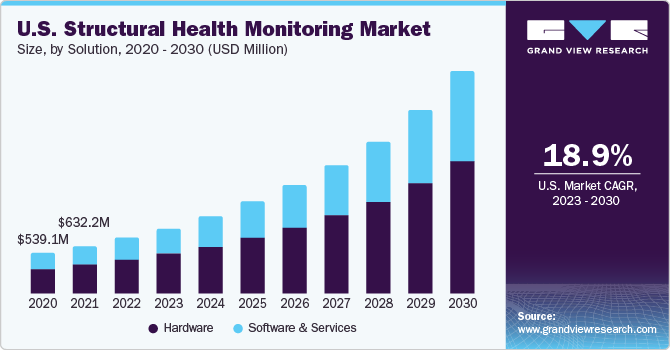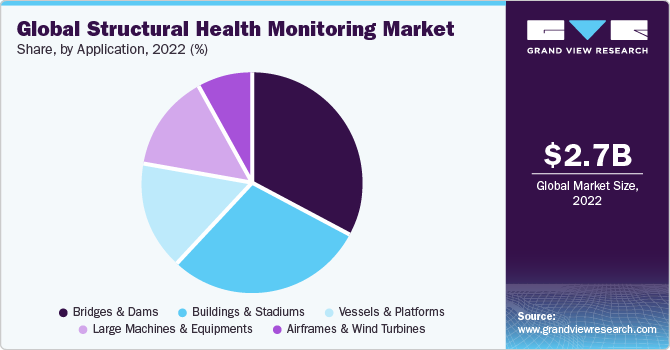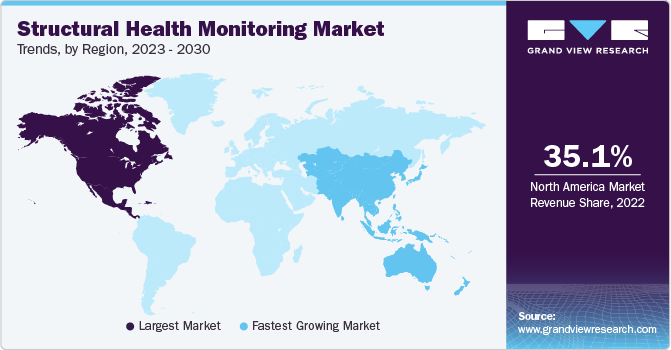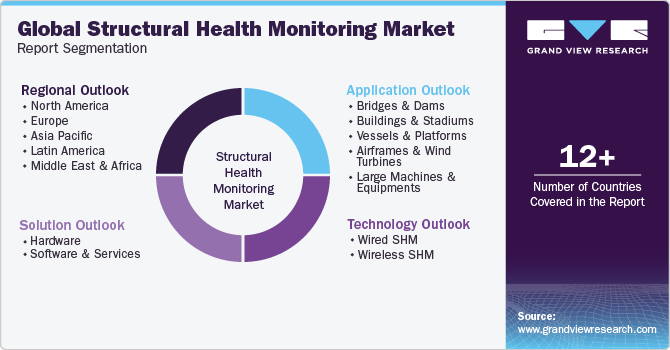- Home
- »
- Communications Infrastructure
- »
-
Structural Health Monitoring Market Size, Share Report, 2030GVR Report cover
![Structural Health Monitoring Market Size, Share & Trends Report]()
Structural Health Monitoring Market Size, Share & Trends Analysis Report By Solution (Hardware, Software & Services), By Technology, By Application, By Region, And Segment Forecasts, 2023 - 2030
- Report ID: GVR-2-68038-587-8
- Number of Pages: 140
- Format: Electronic (PDF)
- Historical Range: 2017 - 2021
- Industry: Technology
Structural Health Monitoring Market Trends
The global structural health monitoring market size was valued at USD 2.66 billion in 2022 and is anticipated to grow at a CAGR of 18.8% from 2023 to 2030. A rapid expansion in the infrastructure sector is poised to drive the market. Increasing government initiatives towards SHM system standardization and public safety also boost market growth. Stringent regulations pertaining to the sustainability of structures and the declining cost of sensors are projected to provide a fillip to the market.

Structural health monitoring is a tool that enables civil engineers to reduce maintenance costs and improve safety measures of crucial architectural structures. Fundamental functions performed by SHM systems include testing and monitoring of performance and health of large machines, airframes, turbines, and structures such as buildings, bridges, dams, and stadiums.
This technology integrates data acquisition and transmission systems, sensors, analyzing tools, measuring amplifiers, and software. The system plays a key role in detecting damages using predictive maintenance, boosts the structure's safety, and enables automatic response, thus saving time and costs. In developing countries, ongoing large projects such as smart cities are using these systems to monitor overall infrastructure health.
Growing infrastructural development worldwide and increasing concerns regarding natural calamities are urging governments worldwide to apply certain regulations regarding SHM, which in turn is expected to work in favour of the market. Increasing focus on low-cost energy harvesting systems and adopting distributed optic fibre further contribute to the market's growth. Surging demand for cost-effective constructions and maintenance is anticipated foster market growth.
Large structures such as buildings, dams, bridges, and other constructions are liable to intense loadings during their lifetime, especially during calamities such as cyclones, earthquakes, and typhoons. These events can result in loss of lives, lead to large-scale damage, and entail economic and social complications. Adopting these systems reduces the cost of maintenance and repairs, as these SHM systems are designed to provide prior warnings in the event of a catastrophe. Therefore, various governments are taking initiatives to promote these systems to improve public safety.
Increasing infrastructural development and growing concerns regarding natural calamities drive the market. The industry is predicted to develop due to the rising need for cost-effective construction and maintenance. Large constructions, such as dams, bridges, buildings, and other structures, must be restored throughout their lives, particularly during cyclones, earthquakes, and strong winds. As these events can result in loss of lives, adopting structural health monitoring can reduce the cost of repairs or maintenance as these systems are designed to provide warning in the event.
Infrastructure largely contributes to the well-being of individuals as well as the productivity growth of the economy. Superior infrastructure helps to eliminate the need for inspection staff and maintenance, thereby minimizing expenses. As a result, the rapid infrastructural development across the globe has propelled the demand for structural health monitoring systems. The rise of infrastructure projects in many industries has unfolded numerous growth opportunities for the market. Moreover, countries like China, the U.S., and Germany increasingly invest in the market. As a result, the demand for structural health monitoring is anticipated to increase over the forecast period.
Over the last few decades, many natural disasters have been linked to damaged or failed essential infrastructure. Such an infrastructure often leads to power outages, communication failures, and collapsing buildings, roads, and bridges. Besides, poor infrastructure also impacts the services of related industries such as transport, retail locations, and others. As such, it is essential to implement useful methods for optimal decision-making across the board, from advising on plant site to structural dimensions and their analysis. Structural health monitoring system plays a vital role in providing real-time information. Hence, the market is anticipated to witness increased demand over the coming years.
The future of the proposed retail, corporate, and transportation projects seems uncertain owing to the growing preference for remote working, the growing popularity of online shopping, and the dwindling brick-and-mortar retail sales. It, in turn, is expected to restrain the demand for structural health monitoring systems. Nevertheless, the demand is expected to recover in the long term as the retail industry is poised for significant growth over the next few years as the market reopens and the construction of commercial establishments, bridges, and other infrastructure also gains traction.
Application Insights
Based on application, the market is segmented into bridges & dams, buildings & stadiums, vessels & platforms, airframes & wind turbines, and large machines & equipments. The bridges & dams segment held the highest revenue share of 32.6% in 2022. The growing number of functionally obsolete and structurally deficient bridges creates significant demand for structural health monitoring systems to monitor and inspect bridges.

Furthermore, the need to address aging infrastructure, mitigate risks associated with natural disasters, and comply with safety regulations has driven the adoption of SHM systems. For instance, according to an Associated Press analysis in May 2023, over 2,200 dams located upstream from residential areas or communities in the United States are deteriorating, posing a significant risk to human lives in the event of failure. It represents a substantial increase in the number of high-hazard dams requiring repairs compared to the findings from merely three years ago.
The buildings & stadiums segment is expected to grow at the fastest CAGR of 19.3% over the forecast period. The rising number of sporting events, such as the FIFA world cup, Cricket world cup, Indian Premier League, and the Olympics, creates demand for infrastructure, including stadiums. Furthermore, governments are also promoting using these systems as they increase the security of the infrastructure.
Regional Insights
North America dominated the global structural health market, accounting for the highest revenue share of 35.1% in 2022. The demand for structural health monitoring systems in North America is increasing due to the airframes & wind turbines increased attention on civil infrastructure repair and maintenance, the aging infrastructure, and increased investments in various airframes & wind turbines. In addition, countries like the U.S. and Canada increasingly rely on structural health monitoring systems to protect the safety and security of structures and people. The fast aging of infrastructure in North America and Europe has prompted civil infrastructure such as bridges, dams, and tunnels to adopt structural health monitoring methods.

Asia Pacific is expected to grow at the fastest CAGR of 20.4% during the forecast period. Due to the significant expansion of infrastructure projects such as bridges, power plants, and smart cities in Asia Pacific, structural health monitoring is gaining prominence. Many countries, including China, India, and others, are boosting their investments in infrastructure, such as bridges and buildings, to support economic growth. The primary drivers for market expansion are rapid urbanization and an urgent need for high-quality infrastructure. As a result of the growing number of civil infrastructure projects, structural health monitoring systems will be in high demand to maintain and monitor the state of each structure and prevent catastrophic failures.
Solution Insights
Based on solution, the global market is segmented into hardware and software. The hardware segment is further sub-segment into sensors, data acquisition systems, and others. The hardware segment accounted for the largest revenue share of 61.9% in 2022, owing to the high cost of integral elements of SHM systems, such as sensors and data acquisition systems. Hardware components must be installed in large numbers to cover structures such as buildings, dams, bridges, stadiums, and airframes.
In terms of different hardware solutions, sensors are projected to be a more prominent revenue contributor in the market. Advancements in sensor technologies, increasing usage of smart materials, and smart structures with embedded sensors supplement the market's growth.
The software segment is expected to grow at the fastest CAGR of 19.4% during the forecast period. Growing demand for wired SHM-based and remote monitoring solutions drives the segment growth in the SHM market. Wired SHM computing technology has revolutionized the SHM market by providing scalable and accessible data storage, analysis, and visualization platforms. The convenience, cost-effectiveness, and flexibility wired SHM-based software solutions offer drive their adoption in the SHM market.
Technology Insights
Based on technology, the market is segmented into wired SHM and wireless SHM. The wired SHM segment accounted for the highest revenue share of 63.6% in 2022. Wired systems are widely adopted for continuous monitoring of distinct types of structures as there is no limitation on long-distance data transfer as they provide reliable connectivity. Additionally, wired SHM systems are already being used for the assessment worldwide of various structures, including buildings, dams, and bridges in different countries.
The wireless SHM segment is expected to grow at the fastest CAGR of 19.7% during the forecast period. The segment has emerged as a technology that will significantly influence the field of structural monitoring and infrastructure asset management. Additionally, the proliferation of the Internet of Things (IoT) devices and the availability of wired SHM computing infrastructure have further contributed to the growth of wireless SHM systems.
Key Companies & Market Share Insights
The industry players are undertaking strategies such as solution launches, acquisitions, and collaborations to increase their global reach. For instance, in April 2021, QUAKELOGIC and SignaGuard, LLC. (a part of MachineSense) launched an innovative process that integrates both firms' patented technologies for structural health monitoring in earthquake-prone areas such as the Himalayas. Frequent earthquakes in the Himalayas region have led geologists to speculate that the whole region is poised for a mega-earthquake at any moment. Since tourism is so prevalent in the area, the damage caused by such a big seismic event could result in millions of deaths.
Key Structural Health Monitoring Companies:
- Acellent Technologies, Inc.
- Campbell Scientific, Inc.
- COWI A/S
- DIGI-TEXX
- Geocomp, Inc.
- GEOKON
- GeoSIG Ltd
- HBK
- James Fisher and Sons plc.
- Kinemetrics
- NATIONAL INSTRUMENTS CORP.
- Nova Ventures Group
- Sixense
- STRUCTURAL MONITORING SYSTEMS PLC
- Xylem
Recent Developments
-
In June 2023, Samsung Heavy Industries Co., Ltd announced the approval of ABS SMART Tier 2 in principle (AIP) for their Hull Stress Monitoring System (HSMS). This achievement is part of a joint development project with ABS, aiming to improve hull safety using smart ship technology. The AIP confirms that the design is feasible and meets the ABS SMART Tier 2 requirements, which include monitoring vessel-specific loads and operations, periodic updates on structural conditions, and utilizing physics-based analysis for a comprehensive assessment and prediction of structural health.
-
In October 2022, Sumitomo Heavy Industries Marine & Engineering (SHI-ME) partnered with Light Structures AS. Within this collaboration, SHI-ME has chosen the SENSFIBTM Structural Health Monitoring system for the third vessel in a series of crude oil tankers constructed for Samos Steamship. By implementing the SENSFIBTM system, the ship's captains and navigators have access to real-time data that is both predictive and actionable, enabling them to take immediate and long-term measures to mitigate the impact of dynamic forces like whipping, slamming, and shearing during the vessel's operations.
-
In August 2022, FDH Infrastructure Group, LLC acquired Smart Tower Systems, LLC, a subsidiary of Rohn Products, LLC. This acquisition allows FDH to expand its range of engineering services in nondestructive testing (NDT) technologies. By incorporating a specialized structural health monitoring solution into its offerings, FDH is enhancing its ability to cater to the needs of global critical infrastructure owners and service providers in various sectors, such as telecommunications, utilities, and renewable energy.
-
In April 2022, Structural Monitoring Systems Plc announced the approval of their Comparative Vacuum Monitor (CVM) sensor technology by the Federal Aviation Administration. This approval signifies a significant milestone for the company, as it opens up numerous opportunities for integrating and utilizing the CVM technology platform in various applications and programs within the aviation industry.
-
In January 2022, Oracle Corporation announced that Xerox had chosen Oracle Cloud to facilitate the launch of new ventures that address major global challenges on a large scale. By leveraging Oracle Cloud solutions, Xerox will bring innovative technologies to the market, with a specific focus on 3D printing for manufacturing, structural health monitoring for vital infrastructure, and augmented reality to enhance customer support.
Structural Health Monitoring Market Report Scope
Report Attribute
Details
Market size value in 2023
USD 3.13 billion
Revenue forecast in 2030
USD 10.48 billion
Growth rate
CAGR of 18.8% from 2023 to 2030
Base year for estimation
2022
Historical data
2017 - 2021
Forecast period
2023 - 2030
Quantitative units
Revenue in USD million and CAGR from 2023 to 2030
Report coverage
Revenue forecast, company ranking, competitive landscape, growth factors, and trends
Segments covered
Solution, technology, application, region
Regional scope
North America; Europe; Asia Pacific; Latin America; and MEA
Country scope
U.S.; Canada; U.K.; Germany; France; China; India; Japan; South Korea; Australia; Brazil; Mexico; United Arab Emirates; Saudi Arabia; South Africa
Key companies profiled
Acellent Technologies, Inc.; Campbell Scientific, Inc.; COWI A/S; DIGI-TEXX; Geocomp, Inc.; GEOKON; GeoSIG Ltd; HBK; James Fisher and Sons plc.; Kinemetrics; NATIONAL INSTRUMENTS CORP.; Nova Ventures Group; Sixense; STRUCTURAL MONITORING SYSTEMS PLC; Xylem
Customization scope
Free report customization (equivalent up to 8 analyst’s working days) with purchase. Addition or alteration to country, regional & segment scope
Pricing and purchase options
Avail customized purchase options to meet your exact research needs. Explore purchase options
Global Structural Health Monitoring Market Report Segmentation
This report forecasts revenue growth at global, regional, and country levels and provides an analysis of the latest industry trends in each of the sub-segments from 2017 to 2030. For the purpose of this study, Grand View Research has segmented the global structural health monitoring market on the basis of solution, technology, application, and region:

-
Solution Outlook (Revenue in USD Million, 2017 - 2030)
-
Hardware
-
Sensors
-
Data Acquisition Systems
-
Others
-
-
Software & Services
-
-
Technology Outlook (Revenue in USD Million, 2017 - 2030)
-
Wired SHM
-
Wireless SHM
-
-
Application Outlook (Revenue in USD Million, 2017 - 2030)
-
Bridges & Dams
-
Buildings & Stadiums
-
Vessels & Platforms
-
Airframes & Wind Turbines
-
Large Machines & Equipments
-
-
Regional Outlook (Revenue in USD Million, 2017 - 2030)
-
North America
-
U.S.
-
Canada
-
-
Europe
-
UK
-
Germany
-
France
-
-
Asia Pacific
-
China
-
Japan
-
India
-
Australia
-
South Korea
-
-
Latin America
-
Brazil
-
Mexico
-
-
Middle East and Africa
-
United Arab Emirates (UAE)
-
Saudi Arabia
-
South Africa
-
-
Frequently Asked Questions About This Report
b. The global structural health monitoring market size was estimated at USD 2.66 billion in 2022 and is expected to reach USD 3.13 billion in 2023.
b. The global structural health monitoring market is expected to grow at a compound annual growth rate of 18.8 from 2023 to 2030 to reach USD 10.48 billion by 2030.
b. North America dominated the structural health monitoring market with a share of 35.1% in 2022. This is attributable to rapidly aging infrastructure such as buildings, dams, bridges, and tunnels in North America which need to be analyzed for further maintenance.
b. Key players operating in the structural health monitoring market include Acellent Technologies, Inc.; Campbell Scientific, Inc.; COWI A/S; DIGI-TEXX; Geocomp, Inc.; GEOKON; GeoSIG Ltd; HBK; James Fisher and Sons plc.; Kinemetrics; NATIONAL INSTRUMENTS CORP.; Nova Ventures Group; Sixense; STRUCTURAL MONITORING SYSTEMS PLC; and Xylem.
b. A rapid expansion in the infrastructure sector is poised to drive the market. Increasing government initiatives toward structural health monitoring system standardization and public safety also boosts market growth.
Share this report with your colleague or friend.
![gvr icn]()
NEED A CUSTOM REPORT?
We can customize every report - free of charge - including purchasing stand-alone sections or country-level reports, as well as offer affordable discounts for start-ups & universities. Contact us now
![Certified Icon]()
We are GDPR and CCPA compliant! Your transaction & personal information is safe and secure. For more details, please read our privacy policy.
We are committed towards customer satisfaction, and quality service.
"The quality of research they have done for us has been excellent."





